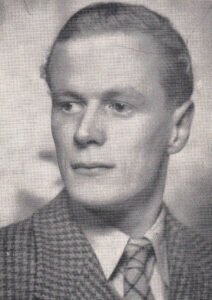
Clement Lister Skelton (“Clem”) was born in Northumberland in 1919. His father was an equerry to George V. He had brief spell at Harrow, due to his connections with the Royal Family, but at 14 he ran away from home and joined the Frank Benson Touring Company, where he played Shakespearian parts. It was the beginning of a lifelong interest in acting.
In 1938 Clem could see that war was coming and joined the RAF. He loved flying, saying “the only downside was being shot at”, but many years after the war he would still have nightmares about jumping out of a burning plane. He was a Spitfire pilot in the Battle of Britain.
After the war Clem did high altitude reconnaissance work – for which he learned how to use a camera. He once took a photo of the Queen Mary in which she accidentally ran down another ship near Clydeside. He was called in by his superior officers who angrily told him to spill the film on the floor, as it must never be seen. But he spilled an empty spool, and a photo of the incident exists.
Post-war Clem once again got involved in theatre. He acted in the West End and with the Viking Players in Scarborough, doing weekly rep and moving from place to place. He used his camera skills to good effect, doing some film work – such as camera work on the film “Whiskey Galore”.
Clem had lots of girlfriends. He once went to visit Queen Mary, who suggested he take Princess Margaret out to dinner. As a penniless actor, he was concerned when she arrived with a whole party and worried about how he was going to pay for it all. He didn’t realise then that Royals don’t pay – the bill is sent to Buckingham Palace.
He continued to act for many years then, aged 37, he went into religious orders founded by the Society of St Paul, who had houses in London and Slough. The Society was active as a publisher and film-maker, and he made films for them for 7 years.
He came out of the order in 62 – 3, never having taken his vows. He met David James, who was the director of Catholic publishing house Burns & Oates. He was also the author of “Prisoner’s Progress” – about his POW escape across Europe. During his first escape attempt his fake papers gave the name of I. Bagerov. James was intrigued by the Loch Ness Monster and founded the “Loch Ness Phenomena Investigation Bureau” to try and catch “Nessie” on film. One day in June, while the days were long and light, he put round-the-clock cameras around the lochside. Because of his camera skills, Clem went with him. He lived permanently on the site, in a caravan.
In 1966 he met his future wife, Alison Scott, who was travelling the Highlands while a student at Edinburgh University. They met when she walked into a hotel and he said “That’s the girl I’m going to marry.” At the time, he was 47 and Alison was 20.
The couple met the agent Henry Morrison through Alison’s brother, who is also an author. They became friends and were encouraged by Henry Morrison and his wife to write. Clem and Alison wrote Gothic novels together under the name of Abigail Clements. It was Henry who suggested the idea to Clem to write the novel which became Hardacre. Clem also wrote the Regiment trilogy, which he originally envisioned as a four-part series. Sadly, he died before he could start work on a fourth and final book in the series.
Alison describes Clem as “a storyteller, with a good sense of story. A group artist, who was happy to collaborate and had no ego about his writing. An actor through and through.” He also had a good scientific mind, and if alive today, would have been an enthusiastic user of Twitter and Facebook. The couple had two sons, who have inherited some of their father’s creativity. One is now a professor of geology, who has also written a book, the other has acted in the past at various theatres in Edinburgh.
Clement Lister Skelton 1919 – 1979
